#I'm actually not sure how to tag this
Explore tagged Tumblr posts
Text
Traintober day 25
Hey guys,
I know I said I wasn't going to really participate in this year's traintober, but I ended up writing something over the last few weeks and figured I'd post it here. I'm a freelance contributor to Trains.com, the web arm of Trains Magazine, (you can read my IRL work here) and I wrote this for that. However, they have a maximum of about 4,000 words for print and 600-1,000 words for web, and this is past 7,000. So even if it makes it into print, it's not going to in its original form. So I'm giving it to you guys. Everything you're about to read is real. There's even an NTSB report on it.
Negligence and Gravity: The Story of a Train Wreck
Prologue
November 17, 1980
Cima, California - a barely inhabited place on a barely used road. A one horse town where the horse had run off. It sits at the intersection of two empty roads, with nothing to show for it but a general store-slash-post office. A true speck on the map, it likely would have been abandoned long ago had it not been for the presence of the Union Pacific Railroad, which sent dozens of trains each day past the ramshackle post office. Many trains rolled right on by, but more and more stopped, checking their brakes, cooling their wheels, or manually setting air brake retainers on each car of their trains.
They did so with good reason; stretching out beyond the post office towards the west, and paralleling the only main road, was a railroad line some twenty miles long. Part of the UP California subdivision that stretches from Las Vegas to Yermo, and then on to Los Angeles, it descends two thousand and six feet between Cima and Kelso, another barely-there town in the California desert. It was and still is one of the steepest portions of the Union Pacific system - accounting for curves and uneven geography, the UP considered the line to be a sustained 2.20% gradient. Any train that exceeded certain weight, braking force, or locomotive limitations was required to stop at Cima, and manually set brake retainers, before continuing down the hill.
As the clock ticked towards 1:50 in the afternoon, three trains entered this tale much like characters in a Shakespearean tragedy.
On the southern passing track is a long grain train, Extra 3135 West. 73 hoppers trail behind a lashup of SD40s, with dash-2 model 3135 on point. The air above the locomotives shimmers and ripples as heat from the motors, exhaust vents, and dynamic brake blisters radiates off into the mild November air.
In the center, a van train rolls past. The train, officially known as both 2-VAN-16 and Extra 8044 West, slows but doesn’t stop as it reaches the summit. Union Pacific has deemed this train capable of descending the grade with no extra precaution, and with good reason. Five locomotives are leashed to the front of this 49 car merchandise train, four SD40-2s trailing behind UP 6946 - the youngest member of the road’s 47-strong class of beastly 6,600 horsepower DDA40Xs. It’s an 8-axle titan in its last months of regular operation, with almost two million miles under its belt. The hot air from Extra 3135 mixes and whirls with the exhaust from the van train as it rolls by, the slab sides of the hoppers amplifying the bangs and squeals from 49 autoracks and piggyback flats. The noise increases as the train nears the end of the yard, the dynamic brakes already coming online as the train crests the summit. The engineer gives a blast from the horn as he passes the head end of the stopped trains, and then the van train is on its way down the hill. The caboose clears the track circuit at the far end of the passing sidings, and recedes into the distance. Within a few minutes the train is a distant shimmer as it snakes its way down the hill, an 8 million dollar steel serpent, bound for the hustle and bustle of Los Angeles.
Finally, there is the train on the northern passing siding. Extra 3119 West is not like the other two - there aren’t four or five locomotives hitched to a gargantuan train, one that stretches into the distance for a thousand feet or more. Instead, there’s a short consist of twenty cars, sandwiched between a single locomotive and a caboose. The cars are piled high with crossties, almost 11,000 of them, urgently needed by a tie gang at Yermo. So urgently, in fact, that if it hadn’t needed to stop and pin down its brakes, this lowly work train would’ve been rolling down the hill ahead of the high-priority van train.
Extra 3119 West, headed by the SD40 of the same number, has been in Cima for just under half an hour. In that time the crew had applied all the brake retainers, checked for defects, and otherwise readied their train for the descent into Kelso. Stopping meant that they’d be following the van train the whole way down, and so once the van train had gotten sufficiently small in the distance, the radio crackles. It’s dispatch, asking quite insistently if they were ready to go. They were, the engineer replies, and without any more to-do, the switch clunks into place, and the signal goes green. A double blast on the horn heralds the train’s departure, followed by the quiet squeal of brake shoes on steel wheels. There is no increased engine noise from the dynamic brakes. The train slips onto the main line, speed increasing slowly. By the time the caboose enters the main line, things are already going disastrously wrong.
Shortly thereafter, Extra 3135 powers up its train and descends the hill in a much more controlled fashion. Silence falls over Cima.
-
Negligence
November 13, 1980
The tale of negligence started three days earlier, at the Union Pacific tie plant in The Dalles, Oregon. Nestled in the valley of the Columbia River, The Dalles is nowadays best known for being the site of the worst bioterrorism attack in the United States, when members of the Rajneeshee religious organization poisoned several local restaurants with Salmonella in an attempt to influence local election turnout. However, that event is still four years into the future at this point, and the big news items in town are the May renumbering of Interstate 80N to I-84, and the March eruption of Mount St. Helens, some 65 miles away.
The Union Pacific tie plant, located between the west side of town and the newly-renumbered I-84, received an urgent order: 20 cars of 9-foot ties, urgently needed in Yermo, California. A mechanized tie gang working in the high desert is running low. Any delay will mean millions of dollars in wasted man-hours. The ties, estimated to number between 10 and 11 thousand, were hurriedly loaded into a series of F-70-1 bulkhead flatcars, modified for crosstie carriage with the addition of steel stakes down each side to prevent shifting. In addition to the 20 cars for Yermo, another group of 5 F-70-1s were being loaded with lighter 8-foot yard ties for renewal elsewhere on the California Subdivision. Inside the plant office, waybills for the 25 cars are being filled out, by hand. One of the most routine and mundane portions of loading railcars, the staff at the tie plant had made strides to simplify their workload; each waybill had been pre-filled with a seemingly appropriate weight figure: “about 60,000 pounds,” done in neat typewritten letters. This saved time, as it meant that tie cars didn’t have to be weighed, and exact quantities of loaded ties did not have to be known. Simple addition of this number to the known light weight of an F-70-1 flatcar (80,000 pounds), gave an estimated weight of 140,000 pounds per car. To the staff of the tie plant, complacent and ignorant, this seemed reasonable. They couldn’t know, because they didn’t want to, that the average per car weight of the 20 cars for Yermo was over 200,000 pounds.
-
November 17, 1980
“Urgent” might have been an understatement, when describing the journey these cars took. It took three days for the 25 flatbeds and their thousands of crossties to travel 1,260 miles across the Union Pacific system. They rolled into Las Vegas just before 1 AM on a manifest train; somehow, despite leaving The Dalles as a single block, a car containing beer had been inserted into the middle, with fifteen cars on one side and ten on the other. The how and why did not matter to the Las Vegas yard crews, who had been informed of the expedited nature of this train. Within minutes, the 26 cars had been taken off the manifest and were being shoved against a caboose that was already waiting. A third shift yard crew made quick work of the beer car and the five cars containing yard ties, but “disaster” struck when it was discovered that the caboose’s electrical system was non-functional. Somehow, despite having a major rail yard at their disposal, no other caboose could be found, and the issue could not be remedied. UP regulations forbade trains from running without rear lights between sundown and sun-up, so the highly expedited train was suddenly forced to cool its heels in the yard until lighting conditions improved.
With the delay, the new crew was scheduled to go on-duty at 8:05 AM, but just twenty minutes before, at 7:45, the Terminal Superintendent was informed that actually, the third shift crew had accidentally cut out the wrong cars - five cars of the 9-foot ties, not the five cars of 8-foot ties - and Extra 3119 West was about to set off with the wrong load. He responded with the unbelievable phrase of “Ties are ties”, and refused to have the incorrect cars set out, before reversing his decision some minutes later. While no other quotes are attributed to him in the subsequent NTSB report, his insistence on having the nearest yard crew drop what they were doing and fix the issue while he personally inspected the re-switching of the train speaks volumes on his mood at the time.
Not that he was of any help. During this frenzied switching, one car of 8-foot ties remained in the train. Its number - UP 913035 - was confused with another flatcar in the train - UP 913015. While minor in the overall sense, this slip-up shows exactly how quickly Las Vegas yard was working to get Extra 3119 West to its destination. When the train was finally ready, there were 19 cars of 9-foot ties behind locomotive 3119, and one car of 8-foot ties. As a car inspector was found, the final lading documents and waybills were presented to the engineer and conductor. Based on the flawed math of the tie plant, the train should have weighed 1,421.25 tons, however the final waybill read 1,495 tons exactly. Aside from being incorrect even against the tie plant’s figures, this weight was exactly five tons less than an internal UP tonnage/horsepower ratio that would determine whether or not the train would have to stop at Cima to apply brake retainers - with a 3,000 HP SD40, the train could not exceed 1,500 tons without incurring serious delays.
Based on the actual weight of a standard crosstie, and estimating how many were on the train, it’s likely that the train exceeded 2,000 tons.
It was customary for two car inspectors to check each departing train for defects and perform a brake test, however on the morning of the 17th, only one was available. Allegedly, he did his job and applied all due diligence, however it must be noted that no one who saw him conduct the test or the inspection lived to tell about it. Considering the haste in which the train was switched, the almost 8 hour delay due to the electrical problems in the caboose, and the close attention from the Las Vegas terminal superintendent, it’s possible that he rushed the job.
Actually, it’s certain that he rushed the job. Investigation of the wreckage would show that over half of the F-70-1 flatcars on Extra 3119 West had brakes that either only partially functioned, or did not function at all. At least three had their brakes cut out altogether. A proper inspection would have revealed that these cars were in a deplorable state of repair, with braking systems that could only be relied on for moral support, and in some cases not even that. But that would have taken time, time that the Union Pacific did not have, or rather, time that the UP did not want to spend.
Since 1979, the railroad had been pushing yards to decrease dwell times on through trains - Las Vegas yard had been given explicit instructions in writing that many high priority trains were to be given a minimal inspection, and were to be on their way again in 15 minutes. Later in the day when 2-VAN-16 arrived in Las Vegas, the head end crew noted that the train had been subject to an abbreviated inspection and air test, essentially rubber-stamping their train, and every other train that came through the yard.
So the inspector cleared Extra 3119 West, because he did know - he knew how much work would need to be done, how long it would take, how long it was supposed to take, and how much trouble he’d likely be in if he brought up the train’s condition.
-
Finally, at 10:00 AM, over 8 hours since it was supposed to depart, Extra 3119 left Las Vegas. Being technically a maintenance of way train, its crew was pulled from the extra board. While these men weren’t inept, one would be hard-pressed to find a less experienced crew on any road train that day:
David Totten, the engineer, had been with the railroad since 1974, but he had only been qualified as an engineer since January of 1979. Noted as a stickler for rules, and a capable railroader, he completed the relevant tests with a 96% score. However his road experience was limited - he’d only descended the grade from Cima 27 times in the last four and a half months.
Alan Branson, the conductor, had been with the company since 1973, but as a switchman in Los Angeles. He’d only been at his current position since April, at which time he was transferred to the Las Vegas extra board.
Cecil Faucett, the rear brakeman, had been with Union Pacific since June of 1978. He’d spent most of his time as a switchman in Los Angeles, and had only transferred to Las Vegas road service in February.
Wallace Dastrup, the head brakeman, had been with Union Pacific since May of 1979. After being briefly furloughed and transferred to Los Angeles, he was sent back to Las Vegas in late October of that year.
The oldest man on this crew was Engineer Totten, who was 31. Head brakeman Dastrup was the youngest, at just 22 years old.
-
Leaving Las Vegas, the trip proceeded normally, with the 3119 providing enough power to bring the train up the 1.00% grade that led from Las Vegas to Erie, Nevada at a steady 20-25 miles per hour. Behind them, separated by time and distance, were Extras 3135 and 8044 West. 3135, with a top speed of 50, left at 10:20, while 8044 (2-VAN-16), left at 12:05. It had a top speed of 70, and would easily catch up to the slower grain train at Cima. If Extra 3119 West had been any other train, it would likely have been profiled to wait in Cima as well, but on this day, the Van train would be following Alan Branson’s caboose all the way to Yermo.
Meanwhile, onboard the 3119, engineer Totten was discovering that his day was not going to go as planned. As the train descended the 1.00% grade outside of Erie, he discovered that the locomotive’s dynamic brakes were not functioning. This meant that the train would have to rely solely on its air brakes for the entire journey to Yermo - a daunting task considering the grade at Cima.
Union Pacific regulations explicitly ordered trains without dynamic brakes to stop at Cima and apply retainers, to maintain a speed of no more than 15 miles per hour, and to stop at the passing siding at Dawes - another speck on the map halfway down the hill - to cool not just the brakes, but the train wheels themselves.
Totten was known to be a stickler for the rules, and so he informed dispatch as he descended the grade out of Erie. Without comment, the Salt Lake City based dispatcher encoded the traffic control computer to put Extra 3119 West into the siding at Cima. At no point was there any mention of finding another engine for the train, or any other means of fixing the situation en-route.
The dispatcher, who wanted to know as little as possible, didn’t care.
-
The train rattled into Cima at 1:29, and Totten balanced it atop the summit, a location about 1,100 feet from the end of the siding. Boots were on the ground as soon as the train stopped moving, with Faucett and Branson moving up the train from the caboose, manually setting the brake retainers on the F-70-1 flatbeds to the high pressure position one at a time. The air was cool, only 62 degrees, and it was slightly overcast - a far cry from the soaring summertime temperatures this part of the state could reach.
As they worked, Extra 3135 arrived. It didn’t rattle so much as it rumbled - 75 loaded grain hoppers slightly shaking the earth as the two men worked. They probably didn’t envy the crew on that train; setting 75 retainer valves, and the long walk from each end of the train to reach them, was a daunting task.
It didn’t take long to set the retainers - at the halfway point of the train, they met head end brakeman Dastrup, who had been working his way down the train as they worked up it. He reported no defects on the head end of the train, and neither did the rear crew. They didn’t know - couldn’t have known - about the abysmal state of the flatcars; they were looking for dragging objects and hissing air leaks, and found none. Their portion of the job done, Faucett and Branson moved back down the train, leaving Dastrup to work his way back to the locomotive. It would be the last time that he was ever seen alive.
Shortly thereafter, the train began to move, engineer Totten moving the train onto the downgrade at the end of the siding to wait for the clear signal. At this point, they were waiting on the Van train coming up behind them, and then they’d be home free. In the caboose, Faucett glanced at the brake line pressures and observed nothing unusual. In the cab of the 3119, Totten was likely readying himself for the downgrade. Without dynamics, it would be a challenging descent, but the air brakes should be able to hold the train without much difficulty.
He had no idea that half his cars had non-functional brakes.
He had no idea that the train was overloaded.
He had no idea what was about to happen to him.
-
Inside the cab of Extra 3135 West, the engineer watched as 2-VAN-16 slipped by with muted alacrity. Across the main line from him, the short work train got ready to depart as soon as the switch aligned. He’d be next, and he readied himself as the other train rolled onto the main line. It built speed quickly, and soon entered the main as his watch clicked over to 1:59 PM. A few minutes later, his turn came, and the signal flashed to green. He powered up his lashup of SD40s, and the train slowly began to descend the grade in full dynamic.
-
“I keep setting air and it won’t slow down!”
-
Inside 2-VAN-16, the engineer began paying less and less attention to the tracks in front of him, and more attention to the radio beside him. 3119 West was having some difficulties with its braking - already a concern for any railroader, but considering that this was the train directly behind him, an elevated level of concern was prudent.
-
In the caboose of Extra 3119 West, the brakes applied as the train rolled past 17 MPH, and were not released again.
-
2.9 miles behind Extra 3119 West, in the cab of UP 3135, the engineer of the grain train could see both trains ahead of him: the distant speck of 2-VAN-16, some 7 miles away, and the work train in front of him. “That looks like it’s smoking,” he remarked to his brakeman. The two men looked into the distance; as the work train passed Chase, another former town on the UP line, it appeared to be smoking heavily - far too heavily for the short distance from the summit it had traveled.
-
On the few F-70-1 flatbeds that possessed functioning brakes, the wheelsets began to heat up dramatically. The brake shoes began to abrade from 2,000 tons of train pushing against them.
-
The Van train had cleared the passing track at Dawes, and was about 5 miles ahead of Extra 3119.
-
Inside the caboose of Extra 3119, the speedometer needle swung past 19 MPH. It was rising at a rate of 1.6 MPH every minute.
-
Things began to happen very quickly. The time was 2:14 PM
-
Following behind the smoking train, the head end crew of Extra 3135 West watched as the signal light at the east end of Chase went red-yellow-green like a slot machine. The only way for that to happen was for a train to pass through both the western home signal, and the western intermediate signal, at a rapid clip.
-
“I have 30 pounds of engine brakes!”
-
Inside the caboose, Faucett and Branson looked at the radio in horror as the speed continued to increase. They’d driven faster than this on their way into work, but now 20 MPH felt terrifying. As they flew through Chase, Branson remembered his training, still fresh in his mind, grabbed hold of the caboose air valve, and put the train into emergency. He heard the brakes come on under his feet and assumed, naively, that they’d just applied throughout the entire train. He had no idea that the brakes would only apply across the entire train if Engineer Totten had the train in emergency as well. He had no idea that by putting the train into emergency while a substantial service brake application was being made, he was causing a pressure relief valve inside the 3119 to continuously open, to try and restore pressure in the train. He had no idea that Union Pacific, in a cost-saving measure, had elected not to equip its SD40s with a brake pressure warning light that could have alerted Totten to what had just happened. He had no idea that UP’s driver training called for engineers to continue to make service brake applications in the event of a loss of braking, instead of immediately putting the train into emergency from the locomotive. He had no idea that putting the locomotive into emergency was the only way to override the pressure relief system.
He had no idea that by trying to save the train, he’d sealed its fate.
Union Pacific rules required the conductor to put the train into emergency if a situation like this occurred. They did not require the conductor to call the head end and inform the engineer. In his panic, and going off of instinct, Alan Branson frantically ran to the front of the caboose to try and uncouple it. He would not make a radio call for the rest of the trip down the mountain.
-
With half the train in emergency, and the relief valve drawing air away from the few brakes that worked, Extra 3119 West began falling down the mountain.
-
Gravity
The story of gravity begins in the cab of the van train, still some five miles ahead. As the engineer kept his attention on keeping his train in line, the radio issued forth the latest news on the disaster unfolding behind them. “I’ve made a full service application, and it’s not slowing down. We’re going about 25 and still speeding up!”
In the cab of an eastbound train, waiting for its chance to climb the grade out of Kelso, the dispatcher’s lackadaisical response could be heard easily. “So you’re not going to be able to stop at Dawes?”
“No. I don’t think we can stop at all.”
The dispatcher said nothing in response.
In the cab of the Van train, the engineer realized exactly what was going to happen. He began notching back the train brakes, and slowly throttling down the dynamics to idle. With one hand on the radio and one on the throttle, he slowly began advancing the throttle even as he called for permission to exceed his 25 MPH speed limit.
The permission he was given would be the last time that the dispatcher offered any meaningful help during the runaway. There was no talk of programming the switches at Dawes to allow the Van train shelter, to offer the four men aboard their one chance at safety. Instead, the dispatcher, hundreds of miles away in Salt Lake City, sat back to watch the chaos unfold, seemingly believing there was nothing he could do to help.
-
Two minutes later, at 2:17 PM, the two trains were still separated by five miles. 2-VAN-16 was just clearing the west end of the passing track at Dawes.
Four minutes later, and Extra 3119 was screaming through Dawes at 62.5 MPH.
5 miles ahead, 2-VAN-16 was running for its life, all five locomotives running flat out in full throttle. For now they had the edge, but they were trying to outrun gravity. All they could hope for was that the rolling resistance of the runaway would eventually cause it to stop accelerating.
-
Three minutes later, and false hope reared its ugly head. Accelerating at a “phenomenal” rate, the speedometer inside the 3119 reached 80 miles an hour and pegged itself there. David Totten, who had been broadcasting his train’s terrifying plunge down the hill over the open radio channel, had no idea that the needle was incapable of indicating a number higher than that.
As his train raced towards destiny, Engineer Totten kept relaying the same false information: “80! We’re doing 80!”
Inside the cab of the 6946, this incorrect information alleviated some worry - if 3119 was topping out at 80, it was possible to use the Van train’s nearly 19,000 horsepower to simply outrun the runaway - once they got past Kelso, at this point a short distance away, the grade lessened to 1%, and the force of gravity decreased.
Then there was an alarm blaring in the cab, and the train began to slow down as they roared into Kelso, the engine RPMs dropping suddenly, horrifyingly. They’d tripped the DDA40X’s overspeed sensor as they passed 75 MPH, and the entire train began to shut down on them. Chaos reigned in the cab for a minute, as the engineer frantically canceled the alert, managed to avoid the penalty brake application, and brought the train back up to full power. Their speed dipped all the way down to 68 before they began accelerating again.
It’s not known what was going on inside the caboose of the Van train, but the 3119, smoke and sparks flying from its wheels, must have been visible behind them.
--
Kelso
The station at Kelso was a tired, yet gorgeous, Spanish Colonial Revival structure located on the north side of the tracks. For a generation it had been a bustling hive of UP crews; a locomotive watering hole and a depot for eastbound helpers. The advent of diesel locomotives, and the elimination of manned helpers on Cima hill had resulted in the station becoming a shell of its former self. The only ties to its former past was the lunch counter, which still served hot meals and cool drinks to the town’s few dozen residents, and the skeleton UP crews stationed at this depot, so far into the desert that not even TV signals could reach it.
On the lunch counter, a cup of coffee cooled, its drinker nowhere in sight. Anyone and everyone who had been in the station were now outside, standing under the trees that lined the old platform, obscuring the station from sight. A few more were on the other side, standing near the MoW sidings on the south side. Further west, beyond the Kelbaker road level crossing, the crew of an eastbound freight waited in “the hole”, their eyes transfixed on the spot in the middle distance where the rails gently curved into view from behind the trees.
The radio continued to issue David Totten’s cool, calm, and collected reports of 80 MPH. With the train out of sight, it sounded like things may end with everyone walking away, but those listening closely heard his reports of an ever-shrinking distance between his locomotive and the caboose of the Van train and shivered.
The blare of a horn sounded, echoing across the desert. A second horn, almost as loud as the first, soon followed, a long continuous noise that would continue for some time, like the seventh trumpet of the apocalypse.
The broad nose of the DDA40X came first, the Van train rocking and rolling behind it as it charged forward. All five locomotives were in notch 8, the sextet of EMD 645 prime movers throwing up huge clouds of exhaust as they ran for everything they were worth. The horn sounded for the crossing, and then the train was past them, 49 high sided autoracks and TOFC cars whipping past with an almighty roar that was over almost as soon as it began.
The caboose zipped past the eastbound in a flash of Armor Yellow, and was gone into the distance. The blaring horn kept sounding, and heads that had turned to follow the Van train turned back to face the east.
They waited ten seconds. Twenty. Thirty. Forty. Fifty.
It’s entirely possible that nobody in the crowd had ever seen a train move as fast as Extra 3119 West.
It’s entirely possible that Extra 3119 West was at that moment the fastest train in North America.
With a thunderous roar not unlike a building collapse, the train streaked through the station, horn blaring continuously. It trailed a cloud of dust in its wake like a comet; the wind its passage created roared through the lineside trees, sending dead branches and leaves flying.
In the cab of the eastbound, the head end crew became the last people to see David Totten alive. He was sitting upright in his seat, calm and collected as though he wasn’t moments away from death, his radio handset in front of his face. He disappeared from sight almost as soon as he’d appeared, and the rest of the train followed. The F-70-1 flatbeds came and went in a flash, and the caboose followed, a barely visible blur of yellow and red.
Heads turned so quickly that they strained necks. The horn echoed off the station building and the waiting eastbound, a receding roar as the train very rapidly got smaller and smaller in the distance. Within moments the only trace of the runaway train was David Totten’s voice, issuing from the radio his final reports. He became a ghost who hasn’t realized that he’s dead.
-
Less than one minute later, the train screamed past the hotbox detector at milepost 233.9, less than two miles distant. It isn’t known whether or not the detector actually found a defect with the train. It could have passed by so quickly that a proper reading couldn’t be taken, it could have still been calling out the speed and condition of the fleeing van train, or possibly it couldn’t handle a number that high; when the train eventually came to a stop, investigators found that the wheels on the flatcars with functioning brakes had reached anywhere from 400 to 800 degrees fahrenheit. The wheels on the locomotive had reached almost one thousand.
What was detected though, was the train’s speed. As the caboose ripped past the steel box mounted on the lineside, the warbling call of the detector - voiced by Majel Barrett-Roddenberry of Star Trek fame - gave a chilling indication of just how wrong David Totten was.
“… TRAIN SPEED: ONE ONE TWO …”
-
Inside the cab of engine 6946, madness was in full swing. A terrible cacophony of noises filled the cabin: All five locomotives were in notch 8, the wind whistled into the cab from worn seals, and the 50 cars behind them banged and rocked as they exceeded their designed top speeds. They were approaching 75 again as they leaned into the curve just outside of Kelso. The big Centennial didn’t like that - its huge, single cast 4-axle trucks groaned and popped in horrifying fashion as it screeched through the curve, wheels just fractions of an inch from leaping over the top of the rail. The rigid wheelsets clung to the tracks by just a hair - ironically, if the overspeed warning hadn’t tripped when it did, the 6946 would’ve likely leapt from the rails here, going into the hole at 80 plus, killing everyone in the locomotive, while leaving the rear-end crew exposed to the runaway, traveling at well over 110 into a stationary target.
On the topic of the overspeed alarm, it was being dealt with - the head end brakeman was waging war against the locomotive’s internals, prying open the cabinet holding the speed recorder, before physically interrupting the travel of the needle, breaking the instrument in the process.
Desperate times call for desperate measures, and there was not a more desperate time than this; as the train rounded the curve, the Extra 3119 West could be seen clearly, moving faster than should have been possible. Their only hope for survival would be if they derailed on the curve that almost took out the Centennial, but it was not to be; the train screamed round the corner with less than thirty seconds of time separating the pilot of the engine from the back porch of the caboose.
-
Inside the caboose of 2-VAN-16, the rear end crew frantically tore cushions off of seats and wrapped them around themselves, as if that might hold off a rampaging locomotive. Hopefully they had time to make their peace with God.
-
The van train kept going. If the overspeed alarm hadn’t cut off the power when it did, and if they then didn’t derail on the curve west of Kelso, it’s possible that they could have outrun it. Extra 3119 West could have derailed, slowed, or perhaps just melted its wheels off, bringing the chase to an end.
But the overspeed alarm had cut in, and so the meeting of the two trains was made destiny by the forces of gravity, and the laws of physics. It was inevitable.
-
At 2:29 PM, 30 minutes and 23.2 miles since they set off from Cima, and 14 minutes and 18.5 miles since Conductor Branson had put the train into emergency, Extra 3119 West collided with 2-VAN-16. The runaway was traveling at approximately 118 miles per hour, while the van train was doing 80 to 85.
This 38 mph closing speed was disastrous to those in the caboose of the Van train. Both porches were crushed in immediately, and the 3119 shoved the rear bulkhead in significantly. The impact then threw the caboose from the track, separating it from its trucks and sending it tumbling down the embankment. It eventually landed on its left side and slid to a stop in the shadow of the disaster. Inside, it was carnage - both men had been thrown about the car before landing on the floor. The rear brakeman would survive with what were assuredly life-altering injuries to his face and back, but the conductor was not as fortunate, suffering mortal wounds to most of his body as he was tossed about the cabin. He would die inside the caboose within minutes.
On the train, the first collision was probably weathered by the 3119. The next three, less so. The rear three freight cars on 2-VAN-16 were triple level autoracks, each fully loaded with 15 or more automobiles. After impacting the caboose and throwing it from the rails, the locomotive continued forward, colliding again with the van train, and throwing the first autorack off the rails. After that, the process repeated for the second one, sending it flying down the embankment.
It was the third autorack that struck home. With the closing speed lowering with each successive crash, and without an anti-climber on the 3119, the autorack rode over the frame of the SD40, stripping the carbody from the frame like a filet knife.
David Totten and Wallace Dastrup were thrown from the cab as their locomotive ceased to exist around them. They landed on the desert floor, already dead from massive internal injuries. The 3119 would remain upright, and eventually came to a stop the quarters of a mile down the track, with everything missing above the frame except the prime mover and alternator.
The F-70-1s were thrown around like toys, flying off the tracks like they’d been cast aside by an angry god. Their wheel assemblies were disassembled into their component parts by the force of the derailment, followed by the cars themselves. The ties were next, flying through the air like javelins, before landing on the ground in clouds of dust, dirt, and splinters.
Finally, the caboose came to a stop. It and the last three cars remained upright, albeit derailed. Inside, Alan Branson and Cecil Faucett patted themselves down, unbelieving that they’d lived through the day.
-
The incredible speeds the runaway reached, and the tragic deaths of three men, triggered a full NTSB investigation. Swarming over the wreckage like flies on a corpse, they recovered a trove of evidence - the locomotive, its brakes abraded and wheels metallurgically altered after reaching almost a thousand degrees. On the ground they found throttle levers, brake controls, the locomotive data recorder, and the air brake valve, all normal in function. The destruction among the flat cars was so total that only 32 of 160 brake shoes, and 78 wheels were recovered. Of both of these, well over half showed no signs of overheating or abrasion, as if they’d never been applied. The rest showed evidence of extreme over-use, as they tried and failed to hold back the train.
The evidence thus far was concerning, to say the least. A train with no dynamics should have been able to make it down the hill… if it had working brakes. If it truly weighed what the waybill said it did.
The NTSB organized a test train shortly thereafter. They salvaged portions of the ill-fated train, including the last three flatbeds and 9,695 of the ties that had been scattered along the lineside. They gathered 17 more F-70-1 flatbeds - between this test train and the wreck, most of the railroad’s 55-strong fleet was involved in the investigation - and loaded them up, before hauling the train back up the long hill to Las Vegas. There, Union Pacific did everything they didn’t do for Extra 3119 West:
They weighed the train on the yard’s scale, and found that even with 1,000 fewer ties, the train still clocked in at a gargantuan 1,948.25 tons.
They inspected the train, and found that of the 20 cars, 16 of them had some kind of brake malfunction. Ten had partial brake function, while six had none at all. The three cars salvaged from the wreck train were included in the former group.
For two whole days, with NTSB investigators watching on, crews from the Las Vegas car department labored frantically in the winter sun to remedy the train's numerous faults. Remember that the single inspector on November 17th had been given scarcely 15 minutes.
When the test train was finally made operable, Union Pacific sent it down the mountain using only the train’s air brakes. They probably thought quite highly of themselves when the train reached Kelso safely, however the specifics of that test were dramatically different than the events of the 17th. To start, the 20 F-70-1s were probably in the best mechanical condition they’d been in for years, thanks to the train being properly inspected. This meant that when the test train descended the hill, it did so with all 160 brake shoes pressing against the wheels.
Furthering the point, the brake shoes were aided by a skilled hand at the controls - Union Pacific, so eager to prove that a train could make it to the bottom of the Cima grade entirely under air brakes, had pulled a highly experienced road supervisor out of retirement to run the test train. Again, remember that David Totten had been an engineer for just shy of two years.
As the investigation dragged on, further evidence came to light: UP’s training for engineers prioritized the use of dynamic brakes, and paid comparatively little attention to running a train with only air brakes down a grade. In fact, the railroad paid so little attention to air brakes that it was found that the UP’s rules regarding steep grades such as the one in Cima were laxer than any other railroad in the country, and were so lax that they fell afoul of the FRA’s minimum requirements for air brake regulations.
With this in mind, the fact that the railroad’s own rules had created a series of unsafe situations for crews seems totally unsurprising: applying the emergency brake from the caboose, not informing the head end if the emergency brakes are applied, and having engineers keep making service brake applications instead of applying emergency braking, were all the wrong moves to make in a situation like the one that happened to Extra 3119 West. A new crew like David Totten, Alan Branson, Wallace Dastrup, and Cecil Faucett, all fairly fresh from their training and relatively inexperienced, followed that training all the way to the end, because they thought it would save them.
-
In the end, the NTSB found that the accident was caused by a variety of factors: UP’s poor maintenance and inspection practices, inadequate training of train crews for hill duties, the underestimation of loads at The Dalles tie plant, and the improper actions of the dispatcher on that day.
Poor maintenance, bad management, a nonexistent culture of safety, and lax training. These are all things that have plagued the railroad industry from day one. The NTSB can only recommend changes, not enforce them; they must rely on the railroads to make the fixes. Change training practices, create better rules, enforce higher maintenance standards - all basic tenets of safe railroading, yet still sorely needed.
So, has Union Pacific made those changes? Has this happened again?
In a very real sense, the answers can be yes, and no, spending on your outlook:
Since 1980 there have been two more runaways on the Cima grade, the most recent one in 2023, and the other in 1997. The circumstances of the two runaways differ - and in the case of the 2023 crash, haven’t yet been fully investigated - but the fact remains that Union Pacific once again allowed a 100+ MPH runaway down the hill not once, but twice. Furthermore, severe under-estimation of railcar loads has caused several other fatal accidents just within the LA Basin, most notably the 1989 Duffy Street wreck, when inaccurate knowledge of the weight of bulk trona and failing dynamic brakes sent a Southern Pacific freight train hurtling down Cajon Pass, and into a residential neighborhood.
However, on the Union Pacific at least, a greater respect for life and safety has been given in the years and decades since the accident. Neither inadequate dynamic brakes, nor improperly maintained brakes, have sent a train flying off the rails on the Cima Grade. The two subsequent accidents, while catastrophic, occurred without loss of life, making the 1980 runaway the last fatal crash on the hill.
Did David Totten, Wallace Dastrup, and the unidentified brakeman of 2-VAN-16 die in vain? Will their story be forgotten to the annals of railroading? Only time will tell.
33 notes
·
View notes
Text
not sure if this is going to make the numbers i hope for, but you never know so, for research in the tags, can you tell me how you feel about fanfiction written in screenplay format (like, straight up movie-screenplay format, nothing in between), would you be ok reading it and why?
1 note
·
View note
Text
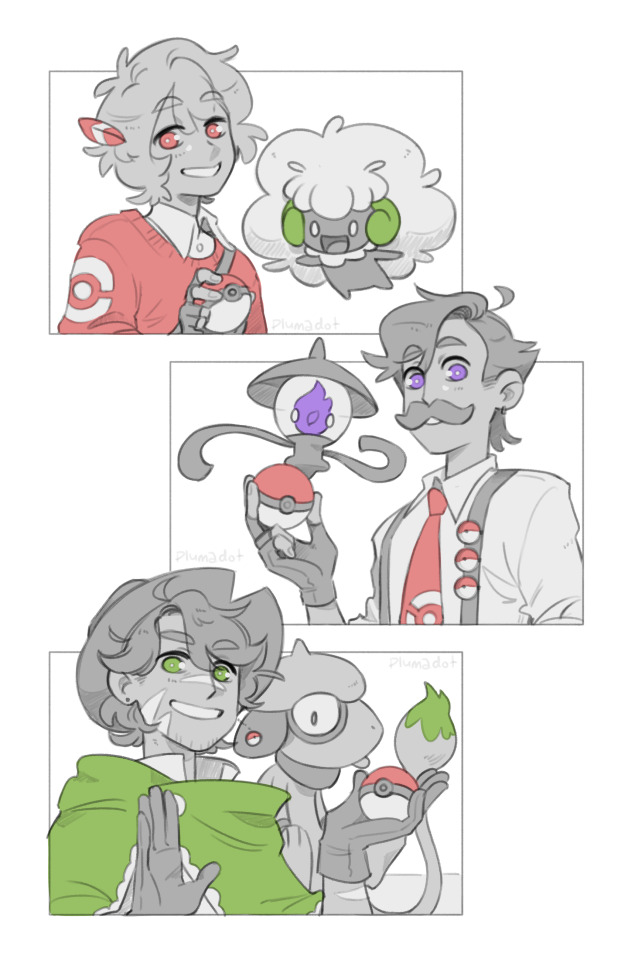
they are rivals!!! and besties!!!!!! bestie rivals!!!!!!!! also scar will 100% sell you that magikarp
#these are just pokemon that i think suit them for some reason#weird crossover#not sure how to tag#traffic smp#?#grian#mumbo jumbo#goodtimeswithscar#this was actually fun to draw#but i'm tired now :)#plume art
4K notes
·
View notes
Text


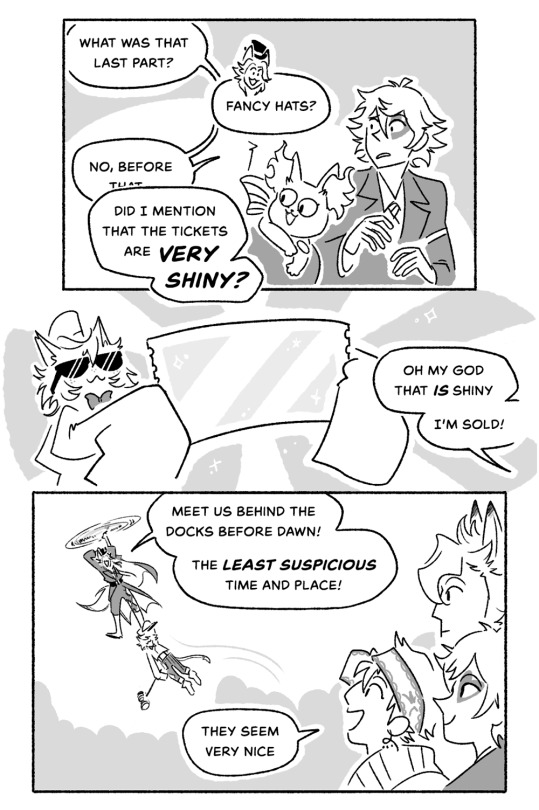
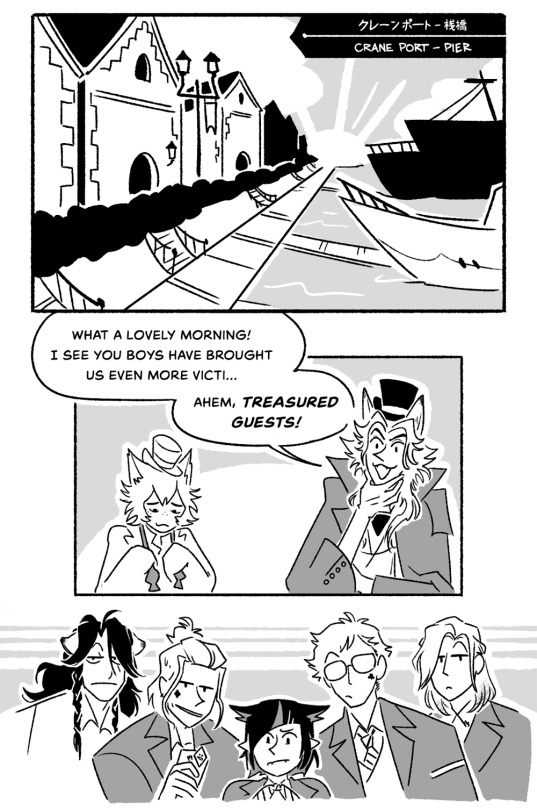
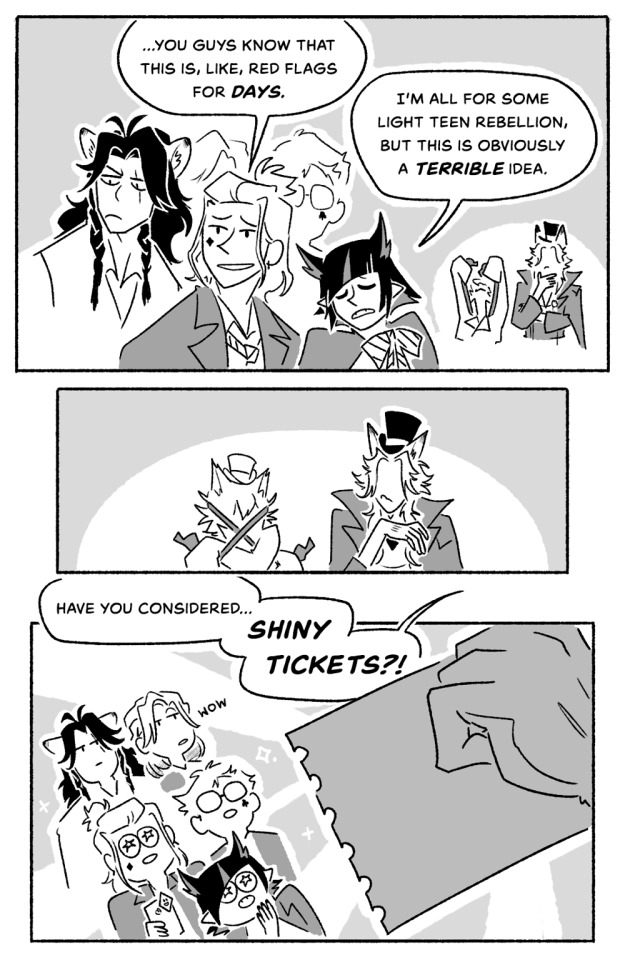
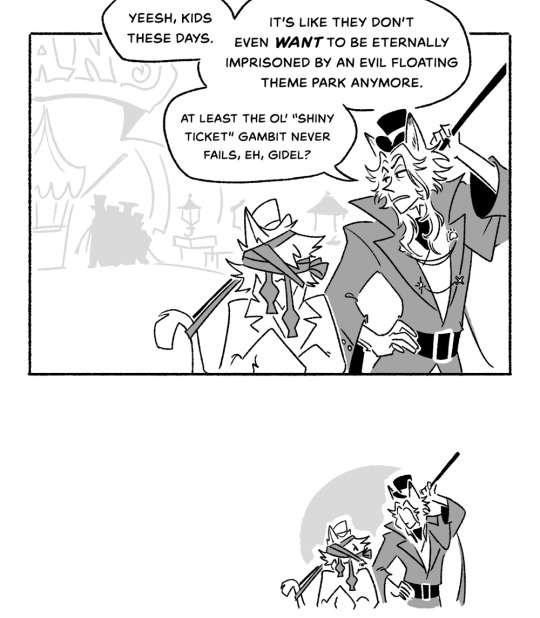
this is basically what happened, right?
(these guys are very lucky that everyone at NRC 1) has the combined intelligence of a sack of bricks, and 2) is easily distracted by shiny things.)

#art#twisted wonderland#twisted wonderland spoilers#stage in playful land#stage in playfulland#these two are SO sleazy and i am utterly delighted by them#can't wait to find out their tragic backstory in approximately 3-4 weeks!#fortunately i have like a month to figure out how the heck to draw their hair (spoiler: i will never figure it out)#also. god. i love it whenever leona accidentally reveals his Mom Side.#he doesn't care about any of this but he WILL be tagging along to make sure no one else gets into trouble#once again he has to be the Responsible Adult and he hates it. the whimsical hat weighs heavy upon his head.#anyway this is me so excuse me while i now talk about diasomnia for three hours#but lilia being all 'kids gotta have some adventure in their lives!' is hilarious#specifically because you know silver would NEVER.#100% silver not only never snuck out but he always went to bed on time AND brushed his teeth AND flossed even when nobody made him.#lilia: aww but you should be enjoying your youth! >:c#silver: i am. i enjoy being respectful and disciplined and honoring you as my father.#lilia:#lilia: maybe i'm TOO good at raising kids#you know i was going to say none of his kids would be involved in this but i actually think malleus definitely would#he would not see it as a moral quandry though. he would just be excited to be invited along.#(the only reason he isn't there is because he was busy admiring a termite-infested beam somewhere and yuu didn't get a chance to ask him)#i mean MAYBE if lilia as his single authority figure told him no then he would have some reservations#but lilia's the one who's screaming HELL YEAH LET'S SNEAK OUT AND DEFY AUTHORITY while dabbing so moot point there#sebek would never and he would rat on everyone else. unless malleus is going in which case he's already there.#and i guess if everyone else is going silver probably would too#but he'd. y'know. feel conflicted about it.
5K notes
·
View notes
Text

had a conversation about my adhd recently then went to make this lmao
#jercy speaks#actual blogging#meme#memes#shitpost#.god idk how to tag this i just needed to share it lol#adhd#actually adhd#kung-fu panda#.sure i'll tag those lmao#.also i'm sure someone's made this exact joke already i just can't find it so i made it myself ¯\_(ツ)_/¯
7K notes
·
View notes
Text

The pishacha are manifestations of evil itself, locked within a cursed amulet. The wearer of the amulet is at the mercy of the demon, known for possessing humans and feeding off their host's chakra energy. However, if symbiosis is achieved, the pishacha can grant its host a myriad of powerful abilities.
I just needed to draw something cool okay. I needed to draw some cool goop and some cool looks okay. okay. if I didn't post this I would have exploded okay
#IT'S VENOM BAYBEE#i can't confirm nor deny if pavitr ever ends up wearing the symbiote- sorry. the demon#i honestly just wanted to get something out lmao#it's eating me up from the inside (the au and the symbiote)#honestly there's a lot of white but fuck it. my boy needs to look good.#the dhoti reminds me of gwenom tbh. you know what i'm talking about. that pink bit in her 'fit#anyway i TOLD YOU the mythology was coming in like a boss >:)#sure i'm tweaking stuff here and there. but mwahaha.... boy does it feel good when mythology actually gets what i'm trying to go for#and spits something out for me to use :D#(crying for hours on end trying to figure out how the black goop does its thing)#anyway nearly 12am. this time i will tag my shit correctly 😤 we will not have a thompson/travasso incident again#pavitr prabhakar#spider man india#spiderman india#venom symbiote#venom#spider man fanart#mythic mumbattan au#myart#artoftheagni
4K notes
·
View notes
Text






2.05 The Aftermath | 5.01 Nameless, Faceless
#criminal minds#criminalmindsedit#cmverse#cmverseedit#userparallels#elle greenaway#aaron hotchner#ellegreenawayedit#aaronhotchneredit#mine#edit#*#parallel*#i love parallels#tag meta#wordles#meta#~#otp: now i think i'm actually gonna miss that#i think about this a Very Normal Amount! and the fact that chris mundy wrote both! it's fine!!#i definitely don't lose my mind thinking about how hotch has absolutely put this together in his head at some point#how elle's assault and subsequent vigilantism and resignation absolutely rattled him to his core#(in part because of the guilt and in part because of his own thoughts/behavior in 1x17 with elle#(another chris mundy episode i might add!!) but that's a whole other can of worms)#how he understood the violation of what happened to her and made sure to personally remove all traces of it#(to atone for his part in what happened to her first and foremost but also because they were close. he understood her!)#and i definitely don't wonder if while it was happening. he thought that. maybe. this was retribution for his part in what happened to elle#i could scream about elle and hotch for days honestly
420 notes
·
View notes
Text


This line. God, this line! It has been eating me up inside for 2 days now, because let's not forget, this line isn't about love, it's about trust. And that has implications that make me want to scream.
It's a direct reference to this moment earlier in the episode:

At the start of this discussion, Style and Fadel still have a kind of playful air about their conversation:
Style: Oh? Not even me? Fadel: You're at 80% at best. I feel like you're hiding something from me in the 20%.
In this exchange, though, there's a sense that Fadel is issuing a challenge, like there's something specific which Style can do to gain Fadel's full trust. And while Style knows there are things he cannot (yet) reveal to Fadel, I think a part of him is determined to be as honest as he can be, which is why he issues a challenge of his own by asking for more specificity:
Style: What do I have to do to gain your complete trust?
Part of this question is a simultaneously inquisitive and deflective - What (and why) do you think I'm hiding (something) from you? - but there's also a moment after Style finishes speaking where he stills and goes quiet that feels... genuine, weighty. Or, as @airenyah has pointed out in her meta on Style in episode 4, the "grounded[ness]" in Style's demeanour is a signal that Style means what he's saying in the moment. Maybe about his own desire to be worthy of Fadel's trust, maybe about how he genuinely does want this relationship to be real in whatever way that matters to Fadel.

I think Fadel sensed that too, because the moment looses all the lightheartedness it had before. Fadel pauses, and then gets a look on his face that just... breaks my heart. There's a sombreness there, like he knows he's going to have to say something that makes him sad. Fadel looks away, and then down, before he seems to steel himself and says:
Fadel: It'll never happen. No matter how much you love someone, I just don't believe that you can completely lay yourself bare in front of them.
Fadel says this like it's fact. Like what he's expressing is something foundational and true and irrefutable. It's not even about his doubt in Style's honesty, because this statement has no qualifiers or conditions put on it to connect it to Style. Rather this is what Fadel fundamentally believes about relationships and trust: he finds the very concept of being fully known and still accepted an impossibility.
Sure, maybe this is because of the falling out (or betrayal or disappearance) associated with the former lover; but I also think it might be because Fadel is acutely aware not only that he's hiding a rather big and dark secret (not to mince words, but: actual literal premeditated murder), but also about what it implies about Fadel. Because being able to kill another human, coldly and clinically and without remorse, takes a certain type of person. Because, yes, Fadel has lived through an absolutely harrowing and traumatising event (his parents' murder), but it's also undeniable that it changed him. Because there's something about Fadel that twisted dark and which he never quite got back. There's an anger, a hurt that colours every moment of his life; that enables him to look a man in the eyes, smile politely, and pull a trigger.
And at this point in their relationship, Fadel's understanding of Style is that he's... well, kind of innocent. Especially in comparison to Fadel and Bison, and even Kant.


Style, who easily reveals facts about his life which Fadel already knows (winning a car tuning competition), making Fadel doubt his own instincts about Style hiding secrets. Style, who also reveals the things Fadel doesn't know, like the tender and secret pain of a mother lost to cancer (which, now that I think about it, Fadel may also know) and his worries about a father who "lost his bearings for a bit" (which he probably doesn't). Style, who tries to comfort Fadel in his own loss by offering a safe space and a sympathetic ear.


Style, who doesn't just see Fadel for his tragedy, but is asking to be given the chance to accept all of Fadel as a person. Style, who not only wants but has the capacity, to be the only person Fadel needs to rely on. Style who, despite the sea of differences between them, understands Fadel on a level that is so very foundational.

I'm going to slightly segue and mention something that may not resonate with everyone, but really hit me in the gut this episode: because I lost my father when I was 16 after he battled cancer for 2 painful years. And this revelation about Style has totally shifted and coloured everything Style has done in a new light for me. Because not only does this totally explain Style's sometimes almost stubbornly childish demeanour (it's common in adults who've had to 'grow up' too early), but also why Style shows seemingly random flashes of insight and maturity when they are most crucial. Notably, Style has this almost instinctive sense of when he needs to back off a sore point with Fadel that I couldn't quite put my finger on until this episode.


I've seen a few jokes about Style's awkward subject change, but I've actually got a friend who I hold very dear to my heart who was one of the only people to give me a sense of normalcy and comfort when my dad was on his last few days and then at his funeral. And part of that was the instinctive way she would know when I needed to just. Not be a grieving daughter for a few minutes. To get a small respite from the overwhelming hopelessness and sense of impending loss. To get a moment to breathe and gather my strength, because knowing I was never going to see my dad again, or hear his voice, or hold his hand was tearing me apart back then. Sometimes she'd talk to me about college drama, sometimes she'd introduce a new kpop video to me, sometimes she'd just ask me what I wanted to eat and take me to go have a meal with her. And sometimes there really just isn't anything else to say other than "I'm sorry." Nothing you say - nothing you can say - is going to ever, ever make this grief go away, and in most cases, it was better when people (especially those who couldn't really understand) didn't try.


And I think if you look at Fadel very closely, there's a moment of genuine surprise (Fadel wasn't expecting the subject change at all) and then... something that looks like fondness mixed with exhausted relief. Because I don't think Fadel was ready to talk about his parents yet. This was honesty he wasn't ready to give Style, mostly prompted because Style himself had willingly been so vulnerable that a part of Fadel wanted to reciprocate. But further down that path lies not only his darkest memories, but also the connection to the part of his life he is not willing to share with Style yet. So this subject change is a relief, it's a blessing, but it's also Style knowing when he shouldn't push any further with Fadel's fragile heart.


Which brings me back to how well the episode's theme of trust (both deserved and undeserved) was woven in this episode. This is true on multiple levels and characters but I'm not even going to attempt to touch Kant in this post because... Lord, that is beyond me at the moment. Someone else needs to do that, pretty please, so I can reblog it and scream.
It starts, somewhat unexpectedly, with Fadel asking for entrance into the intimate spaces of Style's life.


So, this episode was not about Fadel's fear of his own feelings, desires, or even affection for Style - that appears to be fully addressed in episode 4. I think that's why we see Fadel be so physically affectionate and indulgent of Style in this episode. He's come to terms with his lust for Style's body (hence his comfort in initiating sex), he's accepted Style as his boyfriend and so can enjoy Style's playful teasing (still reluctantly, but Fadel is still an introvert even if he's mostly enjoying Style's rambunctious nature), and give into Style's (and Bison's and Kant's) cajoling with relatively little fuss.


He's even comfortable toying with the edges of revealing his darker and more sinister side by reminding Style implicitly about how violent Fadel has the potential to be. Recall that Fadel knows Style knows some of his capacity for violence; he just doesn't know how very thoroughly Style is aware of the full scale of this truth. It does help that Style evidences no actual fear and, in fact, looks positively euphoric. Like, buddy, pal, dearest one... please control yourself.


And yet something very, very telling is the way the show makes it a point to depict Fadel very deliberately getting drunk during the double date. Even before the date has started, Fadel looks to be about half a beer in and we see him constantly drinking, drinking, drinking during the whole date. From the conversation about trust he has with Style while Kant and Bison are being off key and adorable about it, to after Kant leaves and Bison gets worried. And we've seen Fadel cope with emotional and mental distress with alcohol before, so we know that Fadel is internally fighting some kind of very intense battle even as he is also very clearly enjoying moments with Style on this date (most notably when they're dancing by the bowling lanes and when Style asks him to go home with him).
So here's my take: rather than being about love, this is about Fadel fighting to hold onto his own philosophy on relationships and trust. Because as much as I do believe Fadel believes he's telling the truth when he tells Style that 100% trust is "impossible", I think it's clear that's not what he wants.

What he wants is to finish this last job so that the only thing he can't be honest about with Style will finally stop being a factor in his life. What he wants is to fully and completely reciprocate the openness Style seems to be giving Fadel. What he wants is to switch off his brain and let his heart lead for once, to stop fighting a battle he has no desire to win anymore, only he can't. Trust (not love) is Fadel's final frontier, and one which he can't quite give up in spite of himself.


Which is why I think Fadel intentionally gets himself drunk here. Because he wants to let his guard down around Style. He wants to open himself fully, he wants to "lay himself bare" for Style, he wants Style to know the full truth and accept him anyway - and he gets so close, but can't quite get there - because he doesn't know that Style already has.


When Style says this, Fadel thinks it's empty words, not knowing that Style has long passed the bar Fadel thinks is insurmountable. And just like Style was able to offer safety and reassurance to the vulnerability Fadel was showing in episode 4, Style instinctively gets to the core of Fadel's darkest fears again:
Style: One day, I'll be your 100%.
This isn't (just) a promise that Style will wear Fadel's stubbornness down, or that Style will be worthy of Fadel's 100% (which, already, has me in tears, ngl). Beyond that, this is Style promising Fadel isn't ruined for this; that it isn't too late, that whatever hurts and wounds Fadel has can be made whole again. That the kind of honest and all-encompassing and unconditional trust which Fadel says is impossible can, in fact, be his. That Fadel still has the capacity to trust and be trusted the way he so desperately, painfully longs for.
I know a lot of people have said Style in this episode is writing cheques he has no ability to honour, but I think it's more layered than that. Because in a very significant and profound way, Style is wholly deserving of Fadel's trust. Because in all the ways that Fadel has ever known he should want, Style actually IS worthy of his trust. Style knows the truth Fadel is hiding, knows what this man is capable of, knows the danger of being in his arms, knows the likely nonexistent future Fadel has to offer him -- and wants him anyway. Style is a man who would stare into Fadel’s darkness and reach out first. Strip away the complication of Kant being blackmailed and dragging Style into his mission, and Style is literally perfect for Fadel. He is exactly what Fadel wants (and possibly has wanted for a very long time). He is, in fact, exactly what Fadel needs to ever experience anything beyond the shadow of a life he's had so far.

But oh, the cruel narrative means that Style is also, simultaneously, painfully undeserving of Fadel's trust; and this is something Style is very much aware of. I think that's why he's trying so very hard to be worthy in all the other ways he can be. Style's awareness of what Fadel is hiding enables Style to (counterintuitively) be completely honest about his feelings for and about Fadel even as he cannot reveal his motivations. So he gives Fadel as much honesty as he can: offers the vulnerability of his own pain and hurts; the comfort of his true understanding and acceptance.


And just as Fadel's vulnerability in the abandoned factory was met with Style choosing a form of physical connection that prioritised Fadel's pleasure (it's made very clear that Style is jerking Fadel off and that all his focus in that moment was on Fadel, not his own pleasure), so too is this moment met with Style very intentionally choosing to worship Fadel's body with all the tenderness and genuine emotional weight that Style wanted Fadel to have in their first time in the storeroom.
Because, crucially, this was Style giving Fadel the chance to lay himself at least physically bare. This is the closest either of them can get to full honesty with the secrets they both are keeping. It's why Style tries so very hard to show the care and adoration and genuine feelings he has for Fadel. Why he makes sure that the vulnerability of Fadel getting himself as drunk and as relaxed and as trusting as Fadel can allow himself to be is tied only to gentleness and tenderness and pleasure.
Because Style actually knows that Fadel can't (and shouldn't) trust him in the way Fadel truly wishes to.

And as much as I believe that Style genuinely means this from the bottom of his heart, the horrifying full truth is that it is Style that has the metaphorical knife hovering over Fadel's chest. He is the one with the capacity to actually give Fadel a new scar that would truly matter. He is, in fact, the only one Fadel wants to fully trust -- and this, along with Style's compromised heart, makes it so that the circumstances will doom them both.
#this episode broke me in ways i wasn't ready for because of style's backstory so fair warning there's no level of objectivity whatsoever#i'm sure much as already been said about this line and this moment and i'm sorry if i'm just repeating someone else (please let me know!)#i haven't had the time or physical OR emotional capacity to actually read any meta on episode 5#so i apologise in advance if i screwed up anything but these are just my (somewhat disjointed and very emotionally driven) thoughts#the heart killers#the heart killers the series#fadelstyle#style sattawat#fadel#thk ep 5#thk meta#i understand why dunk said this scene was so hard and weighty and was his favourite now#(or at least i think this was the one he means?? I vaguely remember an interview where dunk talked about them talking#before they have sex and how emotionally charged it was)#i'll have to go through my tags and see if i talked about it#but either way our boys both did such excellent jobs this episode#as they have been doing every episode but each time i really am just... newly awed by their talent and my adoration for them grows <3#joongdunk#joong archen#dunk natachai#<my posts>
208 notes
·
View notes
Text

Yay! It's been like two years :'), but my commissions are currently open! The slots are limited, please do take a look if you're interested:
https://ko-fi.com/nedeii/commissions
#you can be sure I spend all that money on art related stuff#and if I ever post anything made with gouache it's going to be thanks to your kind support hehe#I'm only announcing it on tumblr so I'm curious how it goes#pls ask if you have any questions!!#now for the actual tags hm#art commisions#art comms open#commisions open#sky 星を紡ぐ子どもたち#sky cotl#skyblr#kofi commission#sky children of the light#fanart#the comms are not only for sky kids btw!#thank you for taking a look ;w;#sky commissions
445 notes
·
View notes
Text




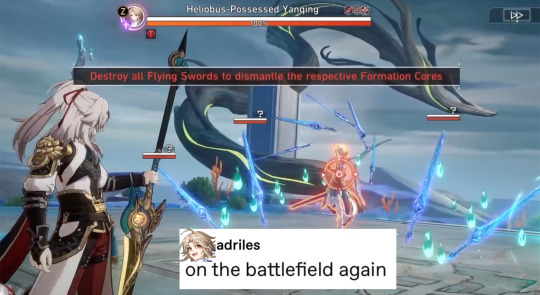



Making Incorrect H:SR Quotes Until I Run Out of (hopefully) Original Ideas - Pt. 3 - Random Screenshot Edition
[Pt. 1] [Pt. 2] [Pt. 4] [Pt. 5] [Pt. 6]
#hsr spoilers#hsr#honkai star rail#hsr textpost#hsr incorrect quotes#honkai star rail memes#hsr memes#honkai star rail meme#hsr meme#stelle#hsr trailblazer#boothill#jingliu#bailu#dan heng#blade#kafka#jing yuan#yanqing#dr ratio#aventurine#sunday#ough so many character tags. what a mess of a post. as always i sure do hope none of these have been done before!#anyways i've once again spent too long on these and can't tell if they're actually funny anymore but oh well i'm still postin' em#i've once again struggled and done my best to make good ID's in the alt text but i still don't know if they're done right aaaaa#also realized while doing so that i forgot to put Jingliu's face over the tumblr post's icon but i'm not fixing it now! just pretend i did#i don't believe i'll make any more like these bc it's harder than you'd think to find the exact images/screenshots to fit with the posts#but these were most of the ones that i felt needed the extra context anyways. now i'll return to my usual lower-effort edits#oh god also ignore how the sandpit one is flipped. i had to do that to get them on the right sides to match the messages 😭
821 notes
·
View notes
Text





i've been pondering lately,,
#asexual#aromantic#aroace#bisexual#queer#lgbt#comic#ok but just to make sure#5 people are not 80% of my friends i just didn't knew how to fill the void#but all that stuff in the fourth panel are things they actually said to me#and i'm still not sure what does all this means lmao#i'm still thinking if what i feel it's actually what i think it is#i made this silly comic bc i'm just like 67% sure??#idk i just rambled in tags again ups
424 notes
·
View notes
Text
Something I really like about timebomb is that Ekko actually knows what he's getting into.
I'm not really seeing it get talked about but in season 1 they mention that Ekko and the firelights help people addicted to shimmer get off it and lead more fulfilling lives within the community. I should probably rewatch the scene for the exact wording (might be misremembering tbh) but that comment implies A LOT.
First: Ekko's mission is helping people where he can, he would probably try and help Jinx even if he wasn't in love with her
Second: He has experience dealing with severe mental illness as that often goes hand in hand with drug abuse, namely depression/suicidal ideation like what Jinx was exhibiting
Third: He's probably mapped out best course of action FOR dealing with this and has already figured out his own limits/boundaries. Meaning he knew what he was getting into trying to talk Jinx out of suicide, and was thus more equipped to deal with the aftermath
Fourth: He's probably helped ex members of Silco's gang. The firelights seem to have a theme of healing and repairing and recovering, so they've probably also learned to forgive. If they're mission is to rebuild the lanes into a safe space, they can't exclude people they don't like, they have to make room for them. I think they fought Silco out of necessity, and I doubt Jinx would be the first person they help who's killed one of them.
These all might be a bit of a stretch but I think it really fits. Beyond that, it shows that Ekko can ACTUALLY help Jinx. As much as unconditional love can do, Ekko has the tools for Jinx's recovery and a path ready for her. He also probably knows that her "healthy" will look different from AU Powder's "healthy." On top of that, I expect he knows how to respect her even in the middle of psychotic breaks and won't agitate her already frail mental state
#if you would like to (respectfully) disagree with me I'll GLADLY talk with you. I can think of nothing but Arcane atm#timebomb#ekko arcane#putting it in the tags bc I want to let people agree with my timebomb takes without having to listen to my other ship opinions#uh on that note I have some Caitlyn and Vi opinions that go a bit hand in hand with this#but I think that in contrast Caitlyn and Vi are mutually self destructive#see neither of them seem to make the others mental health... better.#Vi is desperate and needs love wherever she can get it#and Caitlyn... I'm not sure. I have a hard time reading her but a lot of the vibes I get off her feel like she just likes having the power#over vi#I KNOW THAT'S A STRONG CLAIM#hear me out#Vi in her search for unconditional love does a lot of enabling#a good example is when Caitlyn arrests that henchman in episode 3(?)#Vi is VISIBLY uncomfortable with that and for good reason!#Caitlyn just locked someone up for life for... nothing?#kinda like Marcus did to her (yes Marcus was trying to protect her but I doubt that's how Vi sees it)#but Vi doesn't voice this or push Caitlyn on it#instead she asks Caitlyn not to change#not great communication on Vi's part#but also indicative of how little their values align#and how little Caitlyn actually considers Vi and her problems and history#Caitlyn doesn't help Vi heal and she turns on Vi the second Vi stops enabling her and letting Caitlyn do as she thinks is best#neither of them are ready to deal with the others problems or communicate well#again. willing to discuss this. my opinions are swayable.#I just personally found Caitlyn made the most sense and was most compelling when she was going down facist dictator path#sure she could be more but I don't think the show ever really transitioned her away from that#you can see it in the way she treats Maddy#hhhhhh I should go to bed rather than spill every last thought I've ever had
273 notes
·
View notes
Text

WIP i'm probably never going to finish, because IT'S ANOTHER KLAUZURA SEASON BABYYYYY!!!!

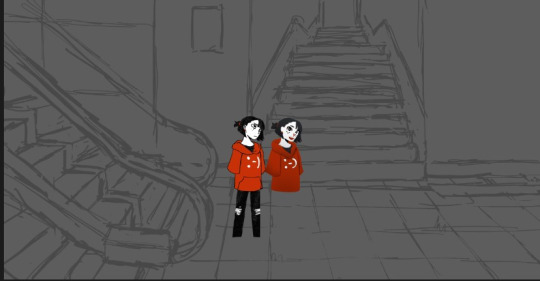
^^(a black and white walk cycle animation of a girl, who's legs aren't drawn yet ) GET CONCEPT ARTED LOSER (This time we're making concepts for our own video game! :) )
#garashir#elim garak#julian bashir#star trek#ds9#I just needed to take a break from animating and I liked the garak drawing sort of#it's sort of corny though but i'm too so it's fine o7#also im not sure how to alt text a video so I hope that my attempt was fine#damn I could write a whole novel here I love tags#klauzury#btw just between you and me I think the Siddig acrylic painting has been giving me too strange dreams Im half ready to ship him off to some#-here nvm you cant write a novel here damn bye I should actually animate oh god :(((((((((((((((
436 notes
·
View notes
Text


the scarf is coming along and soon I'll have to get used to wearing *gasp* actual colors that aren't black or grey or so dark they could be mistaken for black when it's dark out
#still not sure abt the colors#I kinda took whatever yarns felt comfy&homey to me#which might be why it matches my apartment decor a bit too much lmao going out dressed like my apartment sure okay that works#it's also giving ''scarecrow'' to me for some reason (tho.. I could be madder abt it like scarecrow could be a look)#anyways the joy of doing things urself is that u can choose whatever colors and just sorta see how it goes#like idk if it's colorblind combo but I think I'm definitely gonna be wearing it#(my main point wasn't to make something actually super good and great; just to have something to do and practice my knitting which like#I made a hat like 9 years ago and have barely done anything since (aside from like 4 random squares when I once thought I'd knit a blanket#but like dude?? a blanket as the second thing u've ever knitted?? that was too ambitious. So hence a scarf; a small blanket))#aesthetic#I truly dont know any arts&crafts tags#studyblr#booklr#bookblr#december 2024#2024
152 notes
·
View notes
Text
Hey, different post than usual, but this is just a PSA for people who may follow or have purchased anything from @/kagebros, or are looking to join any of the zines run by them @/allsparkzines. They have a history (and present) of tracing for profit.


I don’t think this one requires an overlay. It’s a trace of the yolopark bumblebee shockwave model kit promotional image, as a “sketch”.
Which they changed, once people noticed it! Changed most of it. They traced a different promotional image for the gun, which remained largely the same, even in the final piece (right).



Their matching Optimus Prime poster is a trace of the still from a [ Paramount promo video ], 36 seconds in.



There are several other examples that I can’t fit into this post without making it overly long, but if you have purchased or have been gifted anything from them, there is a chance it has been traced.
Regarding tracing as a tool:
Go hogwild! Trace all you want! Tracing is a very useful tool for learning shapes and forms, but like any other tool, it’s only useful if you use it correctly. The ultimate goal of tracing is to understand. It’s training wheels. Just don’t hide and lie about it, because as soon as you do, it becomes plagiarism.
Even within the finished versions of the Shockwave poster, it’s still clear where parts have been traced or copied without understanding. It’s a shame, because transformers as a franchise having so many toys makes it very easy to make references!
Here's an example of how I use them:

Luckily for me, the Cybertron toys and models are more or less exactly the same. I don't own the toys, so I have two images from a [ toy reviewer ] on top. Many angles to help me understand exactly what's happening. Granted, I could just ask my friend who does own the toy for him in the same pose, but tracing over that directly would make it too stiff and it wouldn't mesh with my style.
TL;DR: Kage traces, blindly and without disclosure, for profit.
#kagebros#not art#uh idk what to tag this#but watch out?#I'm sure plenty of their pieces aren't traced but really selling two posters with traced art as the centerpiece is a little... hm..#so sue me for being wary ig#take this as you will#edit: remember when I just thought it was two posters. better times#IGNORE HOW WIDE THE REF IMAGES ARE my friends and i were watching the 1080p upscale but for some reason the uploader fuckin#stretched the video out to fit the new aspect ratio instead of keepin it the og#but we didn't know? and didn't notice? until like. we were almost done#and then my friend was like hey guys uh they're not supposed to be this wide actually#uhhhh well thanks for reading if anyone read this to the end!#it's very disheartening to see ppl trace shit and then table with it like... what the hell am i doing then#edit: i also think my friend's cybertron optimus is buried under 50 boxes and askin him to move that much for a toy is a lil embarrassing#tfcon#tfcon baltimore
210 notes
·
View notes
Text
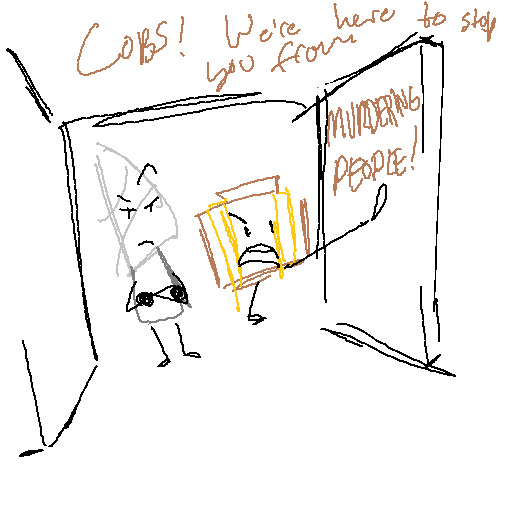
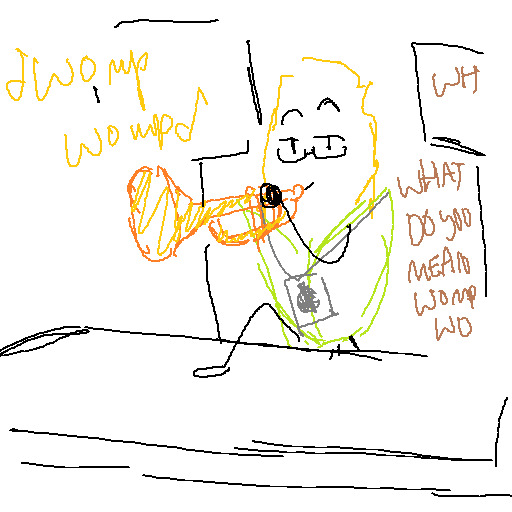
this is what happened in ii16 right
#wheucto#art#inanimate insanity#ii#ii spoilers#ii 16 spoilers#<- i dont know when i'll stop using these tags#ii suitcase#ii knife#ii cobs#WHY is there a metrumpet app i'm SOBBING#that's what inspired this scene but he's playing on a real physical trumpet bc it's funnier#actually him knowing how to play trumpet seems like something cobs would do. no hate to trumpet players it just seems like something he'd d#i was Not sure what pose to give knife#so if it's a silly pose for him to be striking. Thats why
242 notes
·
View notes